History
History of the Presbyterian Community Church of the Rockies
Our church has been a part of Estes Park since before either the town or Rocky Mountain National Park were established. Here are highlights and interesting bits of information about the history of the church, followed by details of the stained-glass windows that grace the sanctuary.
Early Establishment of the Church
Reverend Elkanah J. Lamb, a United Brethren minister, homesteaded Lamb’s Ranch in 1875 and built Long’s Peak Inn, which today is the Salvation Army Retreat south on highway 7. He often came to the Elkhorn Lodge riding horseback and later to the log school house, to conduct lengthy Sunday church services. Since Reverend Lamb did not believe in Sunday School, someone would watch for his arrival to dismiss Sunday School. The first Estes Park church was organized on New Year’s Eve in 1907 in the School House as “The Presbyterian Church of Estes Park.” The original charter documents seven members. Sunday School was held in homes. Reverend John Knox Hall, pastor-at-large for the Boulder Presbytery, was the minister in charge of our organization and from December 1907 to June 1908.
The Downtown Church
Also, in 1908 the congregation bought the lot at 157 West Elkhorn Avenue and began construction of a building for a cost of $4,000, using logs milled from a local sawmill and donated labor. The church had a bell tower that rang every Sunday morning for Sunday School at 10:00 a.m. and at 11:00 a.m. for the church service.
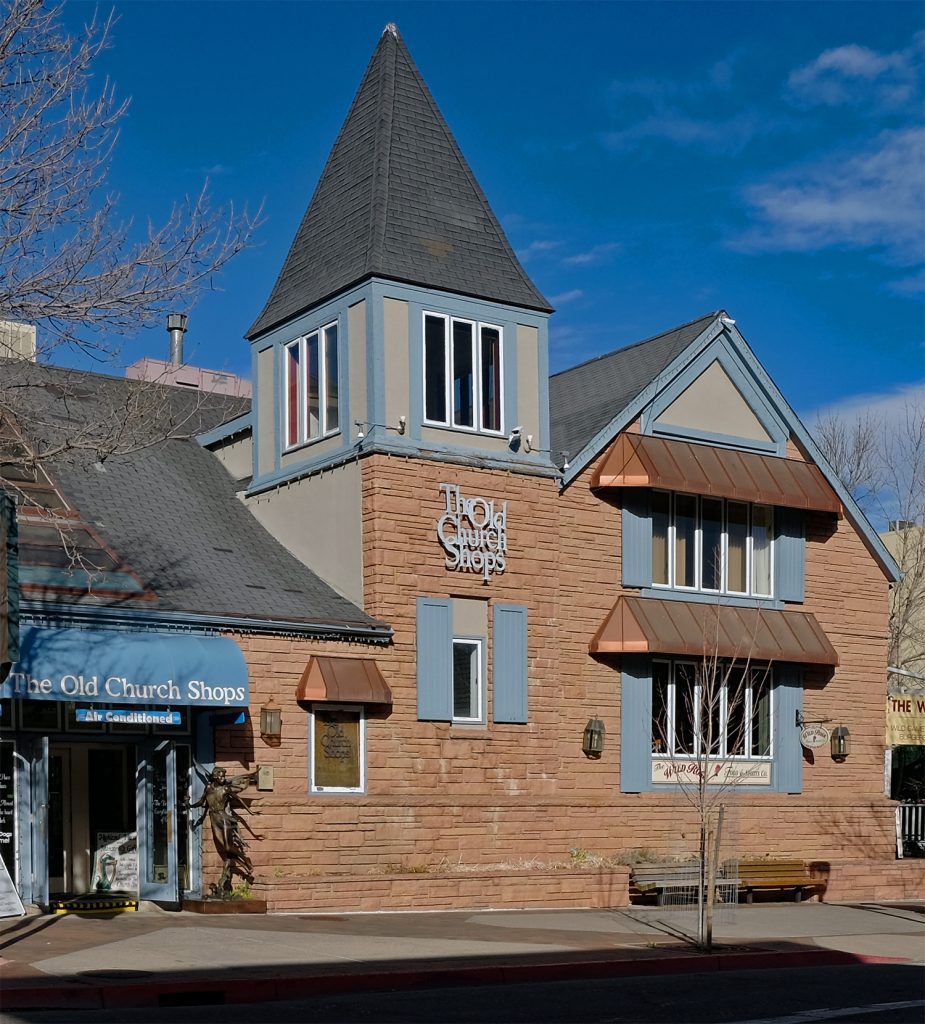
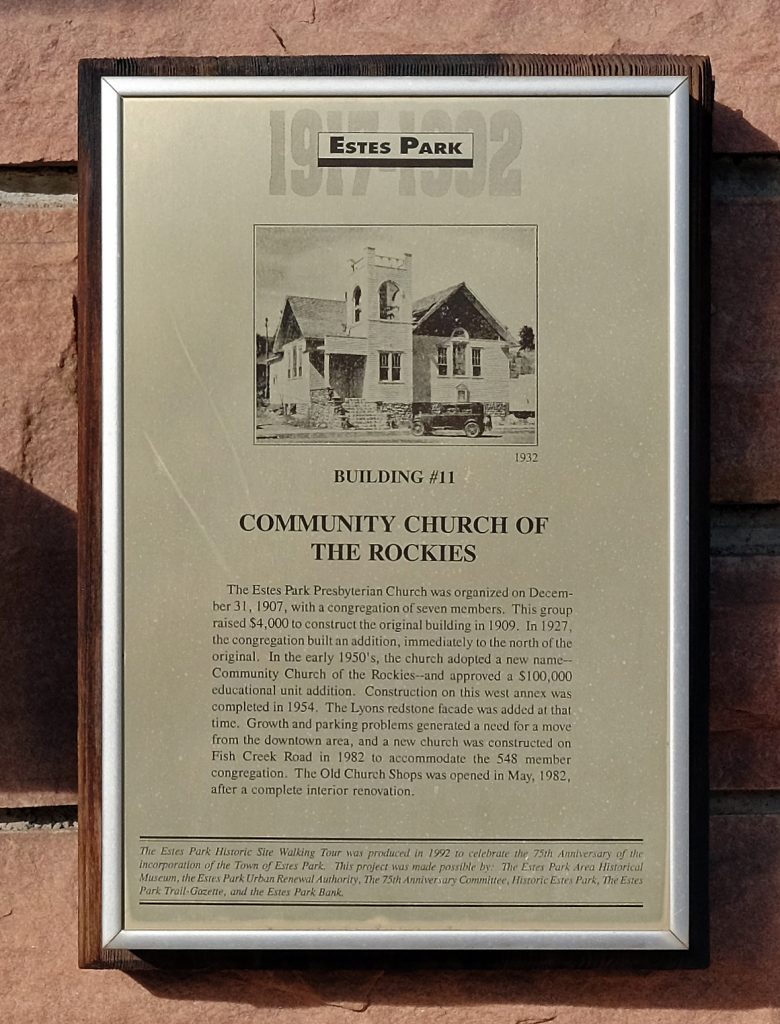
On December 27, 1908, the congregation voted to augment the current five-member Board of Trustees by adding two women for one year. Mrs. C. H. Bond and Mrs. Elizabeth Hoover were elected.
In December of 1909, Reverend J. Mont Travis was elected pastor with a salary of $1,000 and annual vacation of four weeks. The congregation pledged $550 and asked the Presbyterian Board of Missions for $450. For the first twenty-five years, a succession of pastors, sixteen in all, served the church.
By 1911 there was a Sunday School, a Ladies Aid Society, Women’s Missionary Society, Organist, Assistant Organist, and a Chorister who was to organize a choir “right away’!
In 1913, the Estes Park Woman’s Club offered the ladies of the church $300 in cash if they would refrain from fund-raising during the tourist season of that year and the next. The Estes Park High School Commencement was held in the church on May 26, 1913, the day after Session gave its approval.
For many years, ours was the only protestant church in town. In 1915 St. Walter’s Catholic Church was built on MacGregor Avenue. The building is now an apartment, but still resembles a church without its steeple, which was removed.
In 1914, a manse was provided at a cost of $3,000. It was to be rent free to the pastor. In 1916 the vote at the Congregational Meeting was taken by “uplifted right hand”. In 1919, the congregation voted that the pastor could not sublet the manse.
The mortgage for the first church was burned in 1919. On October 1, 1920, approval was given to secure an evangelist to hold special revival services on several days during the winter. In April, 1921, Session voted to instruct the pastor to paint the woodwork in the manse.
O.J. Bowman, a director of Christian Education in the Methodist denomination served the Community Church of the Rockies as a summer-time volunteer adult Bible school teacher during the 1920’s and 1930’s. Mr. Bowman’s activities in the church were not limited to the Bible studies he conducted, sometimes drawing 150-200 attendees. Assisted by his wife at the piano, he also conducted many practices and performances of such oratorios as “The Seven Last Words of Christ”, “Elijah”, and “Messiah”. He was an accomplished fly fisherman, who could be found on the stream between Olympus bridge and the village almost every morning. In the evenings, he was often found dressed in his old corduroy pants and plaid shirt sitting by the miniature golf driving range on Elkhorn watching the tourists go by. He was a fisherman whom our Lord called, “like the disciples of old, to be a fisher of men.”
On April 20, 1925, the call for the new pastor, Reverend Gayle S. Barnett of Chicago, was sent by “aero plane mail”.
At the evening service on April 26, 1925, twenty-one robed Ku Klux Klansmen marched silently into the church and faced the congregation. The leader commended Reverend Harris for his splendid work and presented him with a purse of $52 towards the purchase of a motorcycle when he went to Africa as a Missionary and a lovely silk American flag to take with him.
On September 10, 1925, a resolution was passed commending Superintendent Rupert of the Estes Park Schools, for his efforts to include Bible History in the curriculum of the High School. Also, on September 10, 1925, a letter was to be sent to Mr. Ralph Gwynn, proprietor of the moving picture theater (Park Theatre) for his kindness in giving the free use of the theater on Sunday mornings for the adult Bible class.
In March of 1927, it was voted to use the Easter offering to make up the deficit of the past year’s budget.
Relative stability came in 1928 when William Floyd Kuykendall, a recent seminary graduate, “newly married and handsome” served until 1932.
On December 10, 1929, the Trustees and Session voted to sign a $100 note to the Town of Estes Park for surfacing of the street in front of the church property on Elkhorn Avenue.
In 1937 it was decided to “favor the use” of the old furnace room for Boy Scout meetings. Also, in 1937 it was approved to have a Mother-Daughter Banquet as near Mother’s Day as possible. Dinner was to be served by the men and tickets were 50 cents.
In 1938 the Choir Director was to be paid $5.00 a month and the organist $1.00 per Sunday until the financial situation justified more. The balance in the bank on December 5, 1938 was $9.12.
Reverend Harry Heinecke, grandfather of Carol Pearson, served as a pastor of our church from 1938 – 1946. He would annually offer his resignation and leave the Session meeting, where they would vote to rehire him for another year.
From the 1930’s to the mid-1950’s the summer church services were held in the school auditorium, a large building just north of our present Municipal Building. It could accommodate up to 1,000 people and often was filled to capacity as outstanding guest ministers preached. Soon other protestant denominations began building their own churches in Estes Park.
Adopting our Current Church Name
In 1952, the church changed its name to “The Presbyterian Community Church of the Rockies”. In 1953 the building committee stressed the need for an addition to the church because “we have Sunday School classes meeting in dark rooms, in the kitchen and in a discarded coal bin.” Our church built its last addition to the West Elkhorn building in 1955, which included a new entry, pastor’s study and church offices, additional classrooms, a modern kitchen, and a large meeting room with a stage, which besides serving for church activities, was also used for public gatherings. During the 1960’s most of the Fine Arts Guild’s productions were presented in McAfee Hall. It was named in memory of the Reverend John A. McAfee.
In 1968, Session voted that no easement be granted to the Town of Estes Park Light and Power Department for poles across our church property. On August 25, 1970, Session voted to grant permission to the National Park and Forest Service to use the church properties for emergency helicopter landings, with the two agencies signing a “disclaimer” to the church releasing it from liability regarding any accidents on the property.
In September of 1970, Session voted to send a letter to the Town of Estes Park requesting that it please “give consideration to the elimination of any future parades on Sunday mornings”. During the late 1970’s the predecessor to Crossroads Ministry was set up in the church basement to aid those in need.
Services were held at 157 West Elkhorn Avenue, now the location of the Old Church Shops until 1981. The open entryway lent itself to pranks, as a local teacher’s Volkswagen Beetle on occasion was found there.
The Move to Brodie Avenue
Due to congestion downtown and to be closer to the schools, the congregation purchased land on Brodie Avenue for a new location. The church was designed to complement the native environment and provide inspiration.
The final services at the downtown church location were on December 20, 1981. On December 27th, services were held at the Seventh Day Adventist Church. The church offices were, moved to the house on West Elkhorn and Spruce, the present “Spruce House” while waiting for the new location to be completed.
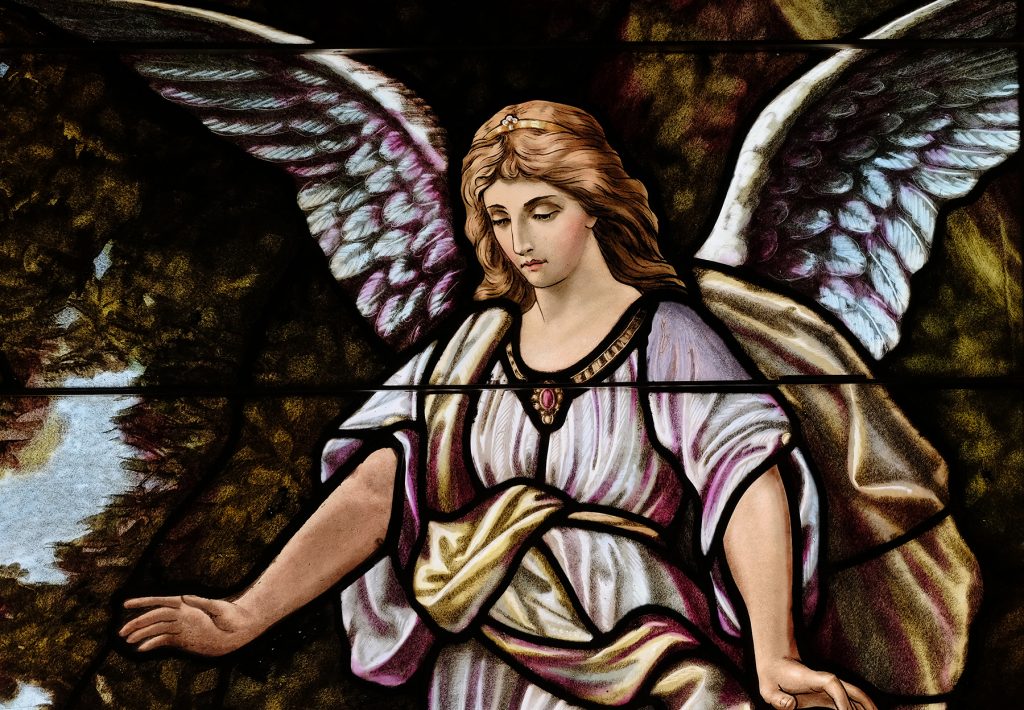 Groundbreaking for our present sanctuary took place on July 12, 1981. A year later to the day, the needed Certificate of Occupancy was received. After the CO was received, the temporary church office of files, library books, church music and other important church property were moved to the new church on July 13th, 1982. The grand piano followed on the 14th. On July 15th,1982, the muddy waters of the Lawn Lake flood went raging through the temporary offices at the corner of Spruce Drive and Elkhorn Avenue on the Fall River. There was nothing left but the telephone sitting on the floor.
Groundbreaking for our present sanctuary took place on July 12, 1981. A year later to the day, the needed Certificate of Occupancy was received. After the CO was received, the temporary church office of files, library books, church music and other important church property were moved to the new church on July 13th, 1982. The grand piano followed on the 14th. On July 15th,1982, the muddy waters of the Lawn Lake flood went raging through the temporary offices at the corner of Spruce Drive and Elkhorn Avenue on the Fall River. There was nothing left but the telephone sitting on the floor.
All the beautiful historic stained glass windows were moved from the original church location to the new facility in 1982. Two (Clatworthy & Higby) were installed as the inside wall of the library along the Narthex. As changes were made in the library, they were moved to their present locations. Other windows bear the names of James, Church, Hayden, Schwartz and Godfrey, important names in the town’s history. Pictures of the windows and information about their dedication can be found here.
History of the Organ
The organ of Presbyterian Community Church of the Rockies is a complex and versatile instrument dedicated to the praise and worship of God through Christ Jesus our Lord, and to the ministry of this church.
The organ’s vast resources include the original pipe organ built by Schantz Organ Company in 1982, containing 1,278 pipes in 21 ranks and 25 stops. In 2009, the Veritas Organist Company and its president Graham Blyth designed and installed a renovation and augmentation of the original instrument, preserving and focusing on the core Schantz instrument. A new 3-manual and pedal playing console with 255 memory levels and 55 new tonal ranks in 46 stops were added through state-of-the-art digital technology. A new computerized control system was installed, and the pipe and digital resources were then merged and voiced seamlessly to provide a palette of 73 total stops. Sensors on organ pipes monitor temperature changes and adjust digital voice pitches to match the pipe voices.
Complete choruses of the four organ tonal families — principals, flutes, strings, and reeds — exist in the organ’s four divisions. The range of dynamics stretches from the organ’s softest voice, the Flauto Dolce, to the powerful fanfare trumpet, the Tuba Mirabilis. These, and everything in between, allow the organ to whisper a prayer, welcome a king, accompany choirs of angelic voices, or lead congregational hymns. Pitches extend upward from two 32-foot stops, playing pitches two octaves below the unison, to stops with tiny pipes and extremely high pitches 2 and 3 octaves above the unison. Mixing pitches and various tonal colors allows the organist to orchestrate the instrument’s ensemble to the musical needs of the moment. The entire project was managed and executed by Jerry Akers of J.W. Akers & Associates in consultation with Organist Larry Gillum, and this firm continues to provide ongoing maintenance.
Additions and Enhancements
The building has been enhanced over the years through various memorials. The Latin Cross and Presbyterian Symbol, which adorn the west wall of our Sanctuary, appear to be made of stone; however, they are made with elevated metal work sculpted to resemble mortared stone. These memorial gifts were made and donated by Jerry Spencer in 1987. Additions include the Pipe Organ, the Meditation Trail with Columbarium, Shelter, and Outdoor Chapel, all overlooking the wetlands of Fish Creek and striking views of Longs Peak. The Outdoor Chapel earned an American Institute of Architects Merit Award for Design in 1999.
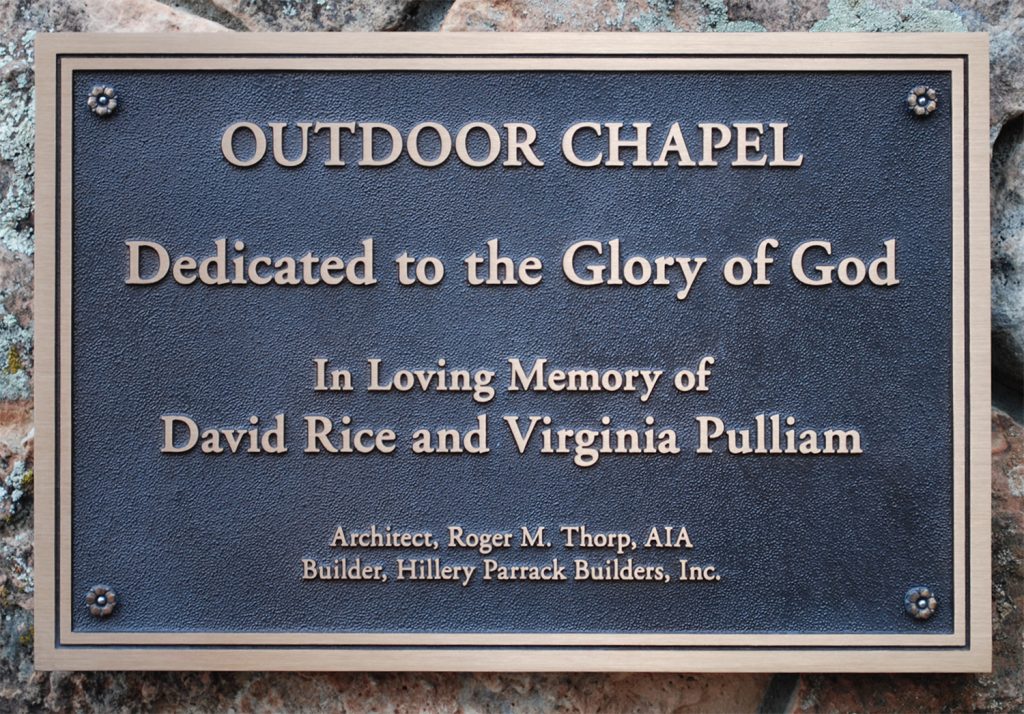
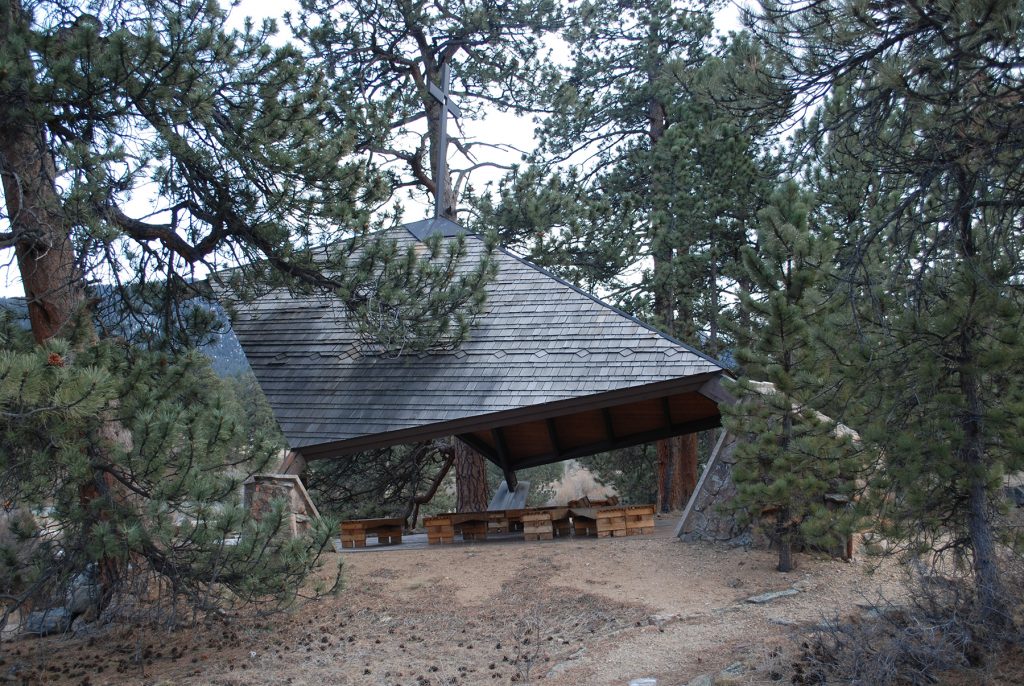
The original bell was also moved to the existing church, only to be stored in the shed until a new bell tower was built in 1996, with memorial contributions made in honor of Mollie Holmquist, who lost her life in an auto accident on her 21st birthday, March 10, 1994. The bell, once again, welcomes members and visitors alike by ringing before church services.
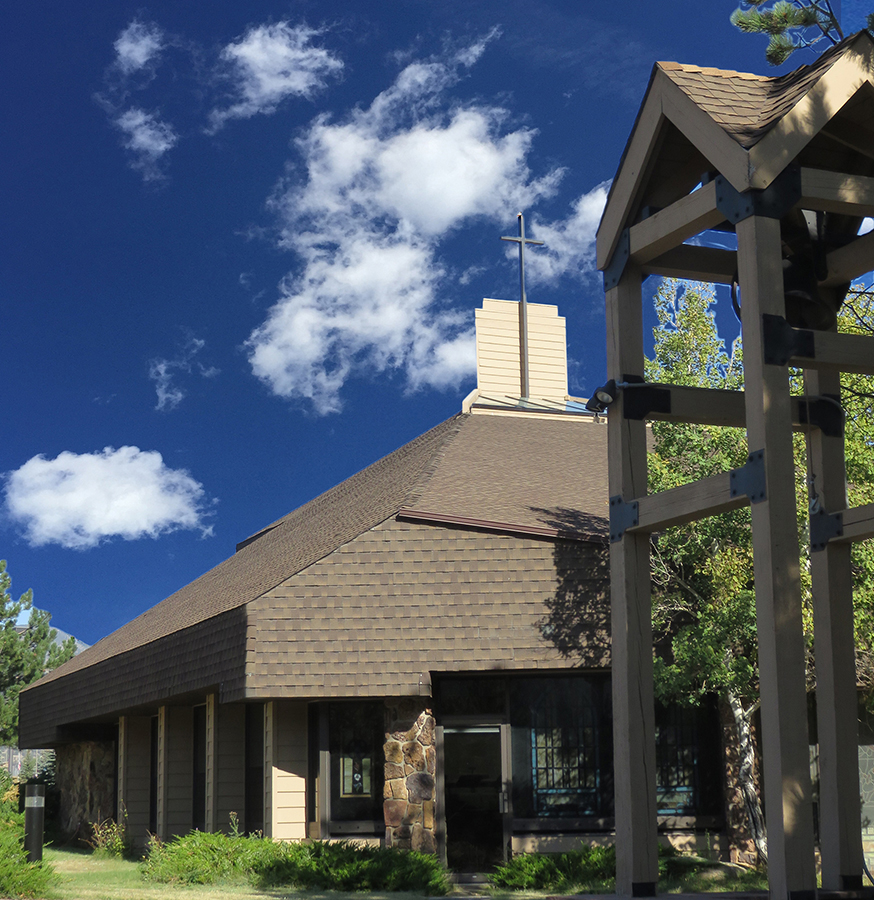
The church’s heritage dates back to Scotland, as many of the early members were Scottish-Americans. Every year in September the church celebrates its Scottish heritage with the “Kirkin’ of the Tartans” ceremony, which includes bagpipe music and blessing of the clans’ colors. An original poem was written by the Reverend D. Ned Linegar in honor of the Centennial of the Presbyterian Community Church of the Rockies. A hymn of celebration entitled “Blessed Are They Who Come To The Father”, written in honor of the Centennial by Larry Gillum, church organist, was dedicated during the Kirkin ceremony, held on Reformation Sunday, October 28, 2007.
The church is committed to the community, welcoming newcomers, serving its long-term members, and providing a wonderful venue for community events and activities.
This is history that was researched by the Centennial Committee:
Verlene Thorp and Harriet Burgess, Co-Chairs
Jim Carpenter, Betsy Evans, Frank Gaines, Sharyn Gartner, Bob Hamblin, Rev. D. Ned Linegar, Betty Maitland, Barby Nichol, Carol Nussbaumer, Carol Pearson, Amy Protto, Mark Richards and Dot Rohrbaugh
